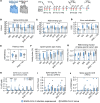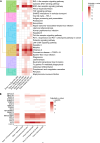Modulation of innate immune response to mRNA vaccination after SARS-CoV-2 infection or sequential vaccination in humans
- PMID: 38716734
- PMCID: PMC11141904
- DOI: 10.1172/jci.insight.175401
Modulation of innate immune response to mRNA vaccination after SARS-CoV-2 infection or sequential vaccination in humans
Abstract
mRNA vaccines are likely to become widely used for the prevention of infectious diseases in the future. Nevertheless, a notable gap exists in mechanistic data, particularly concerning the potential effects of sequential mRNA immunization or preexisting immunity on the early innate immune response triggered by vaccination. In this study, healthy adults, with or without documented prior SARS-CoV-2 infection, were vaccinated with the BNT162b2/Comirnaty mRNA vaccine. Prior infection conferred significantly stronger induction of proinflammatory and type I IFN-related gene signatures, serum cytokines, and monocyte expansion after the prime vaccination. The response to the second vaccination further increased the magnitude of the early innate response in both study groups. The third vaccination did not further increase vaccine-induced inflammation. In vitro stimulation of PBMCs with TLR ligands showed no difference in cytokine responses between groups, or before or after prime vaccination, indicating absence of a trained immunity effect. We observed that levels of preexisting antigen-specific CD4 T cells, antibody, and memory B cells correlated with elements of the early innate response to the first vaccination. Our data thereby indicate that preexisting memory formed by infection may augment the innate immune activation induced by mRNA vaccines.
Keywords: Adaptive immunity; Immunology; Innate immunity; Vaccines.
Figures








References
Publication types
MeSH terms
Substances
LinkOut - more resources
Full Text Sources
Medical
Research Materials
Miscellaneous

